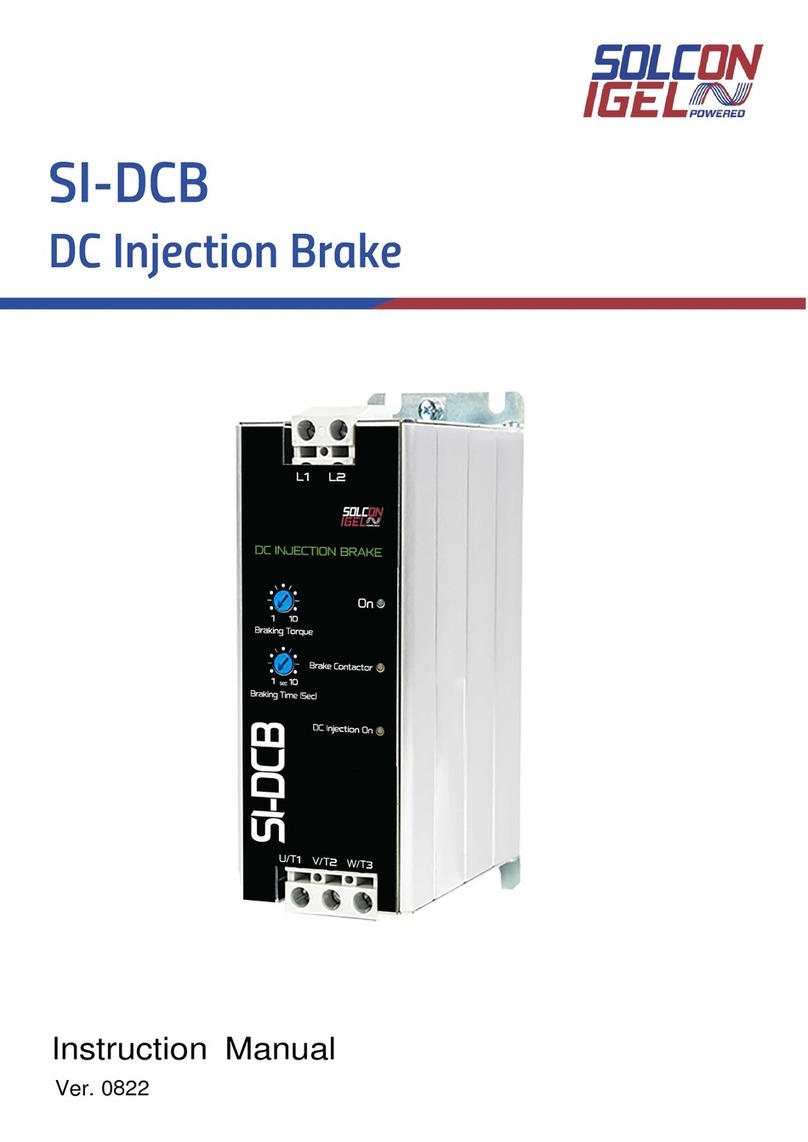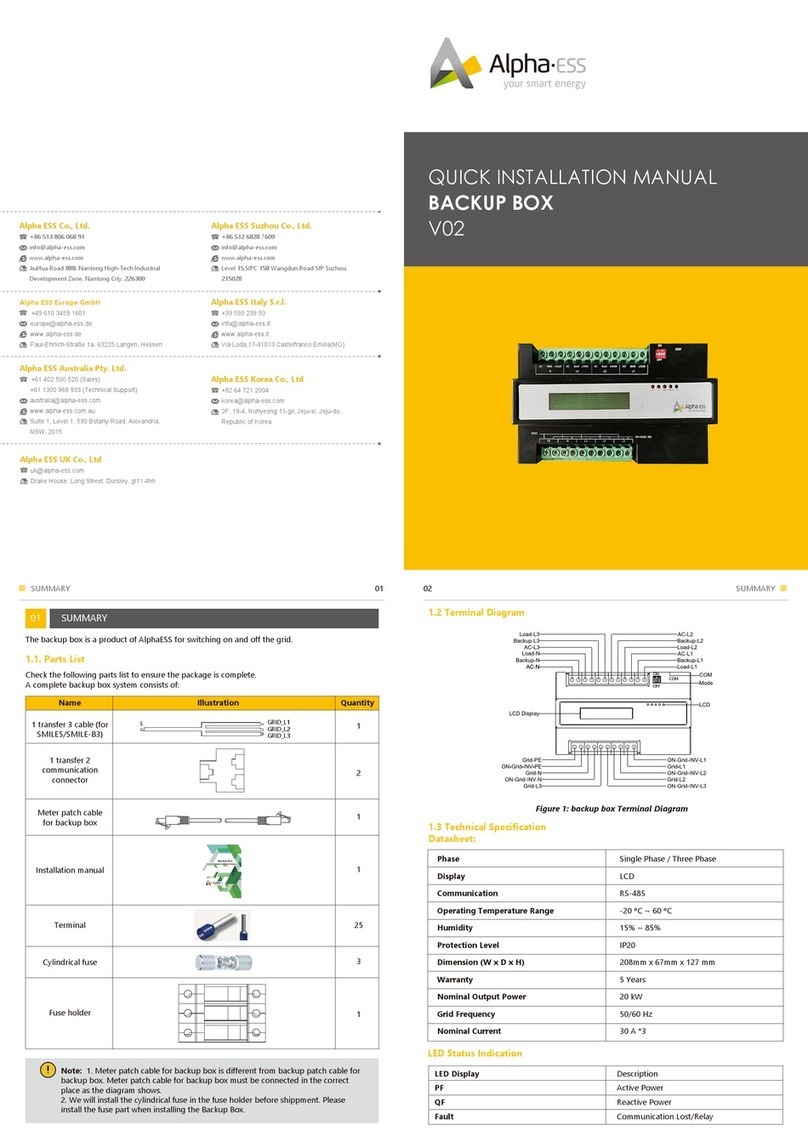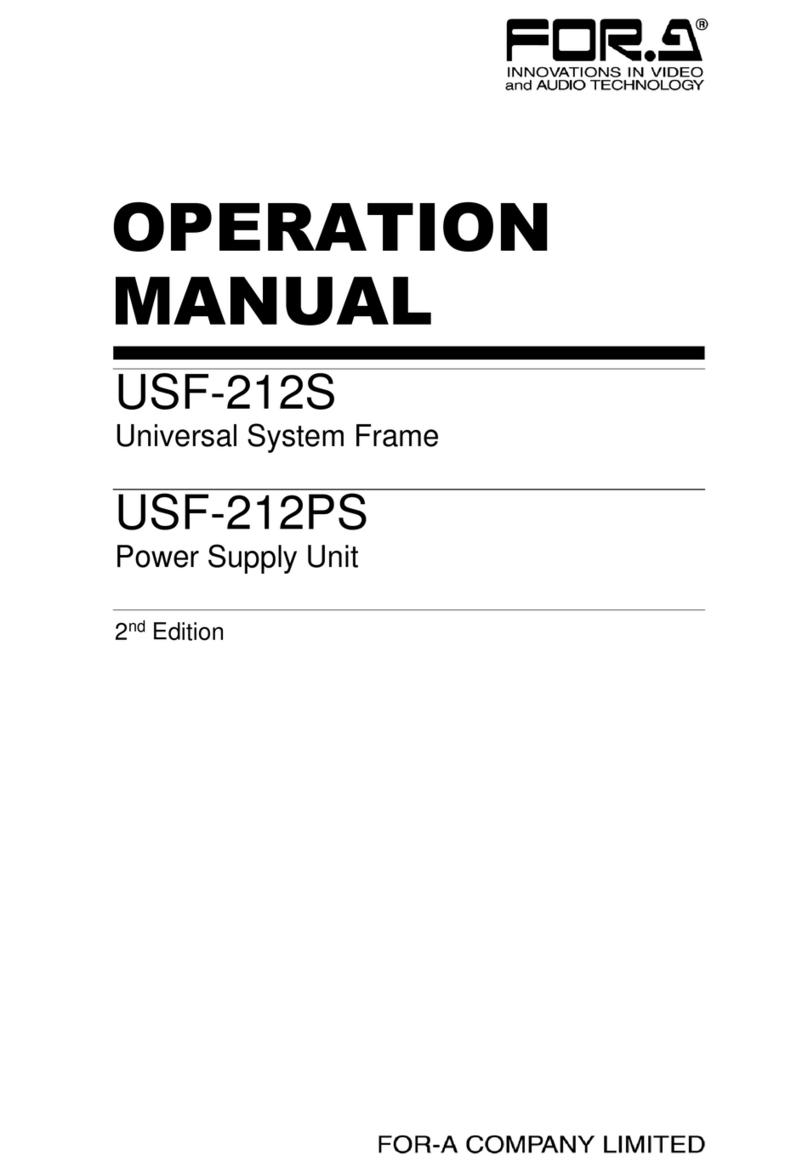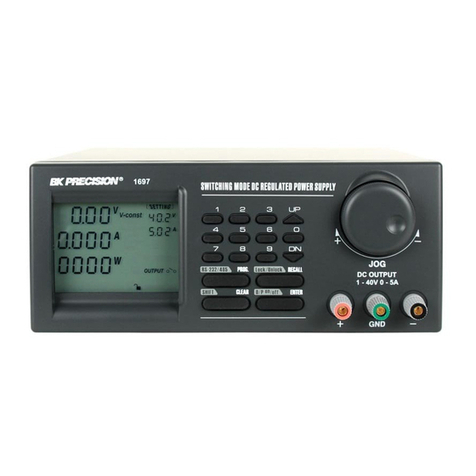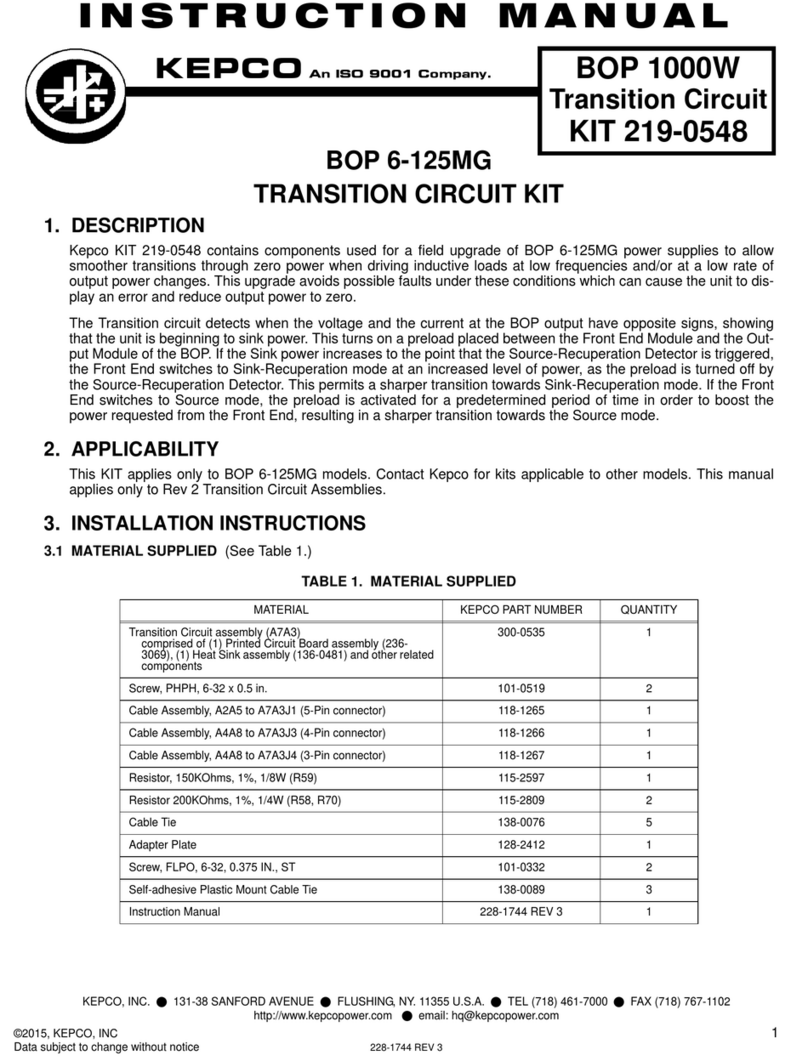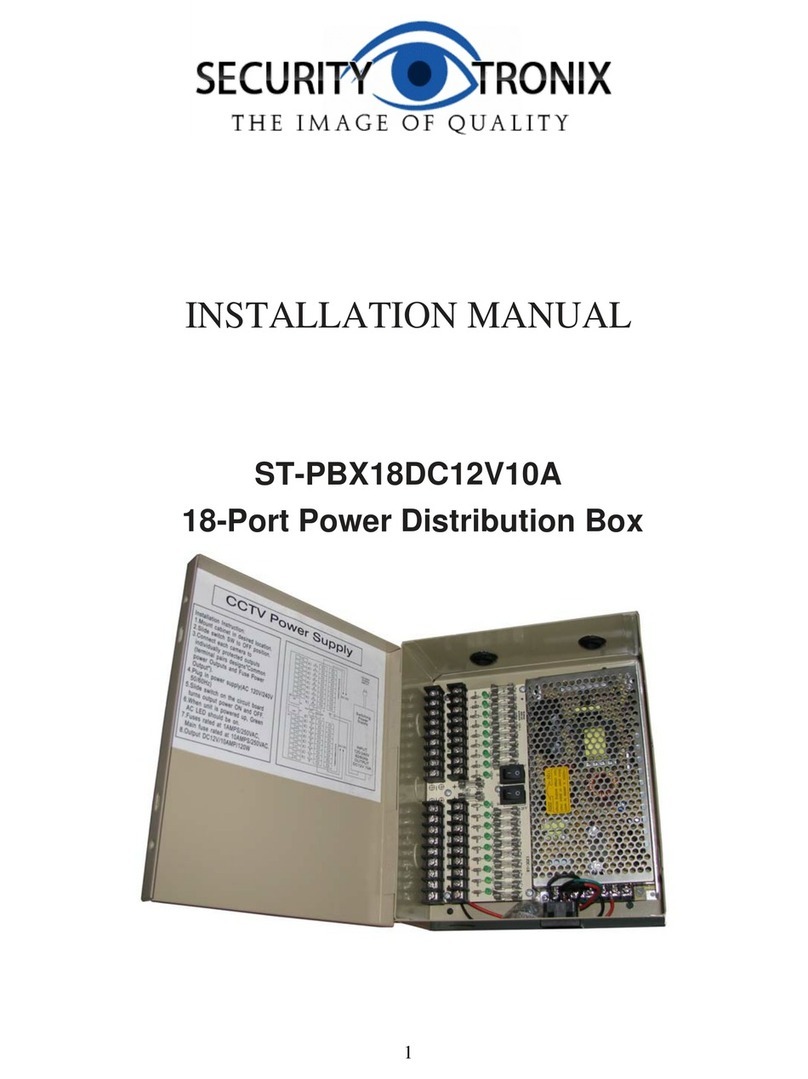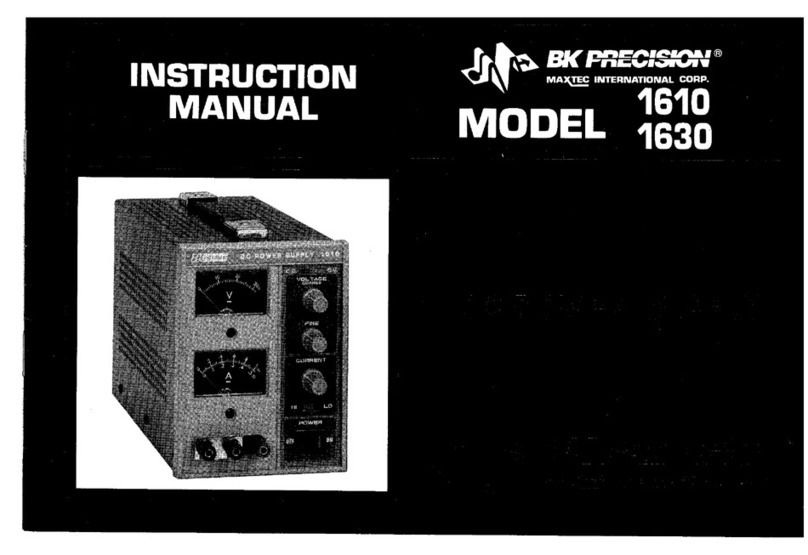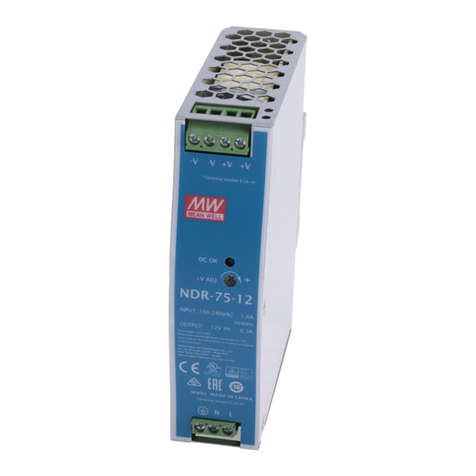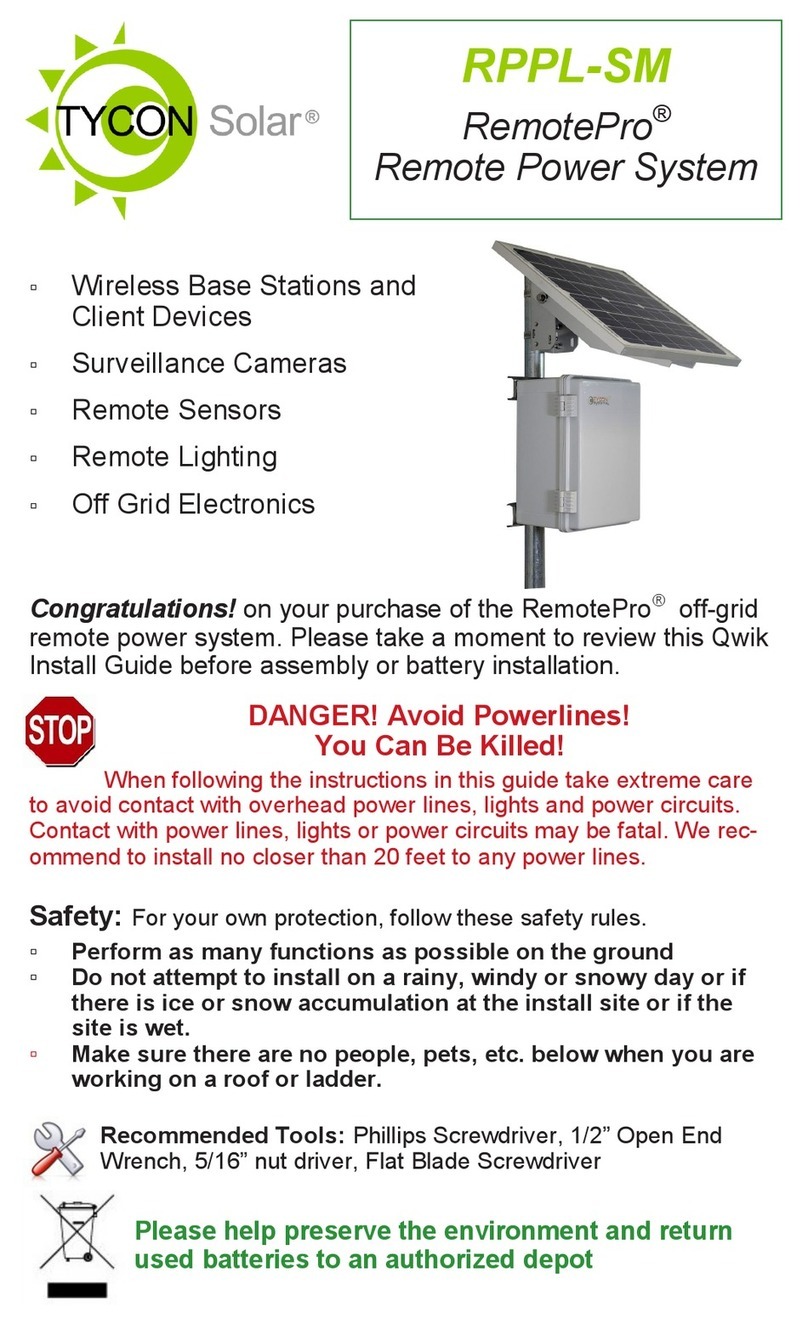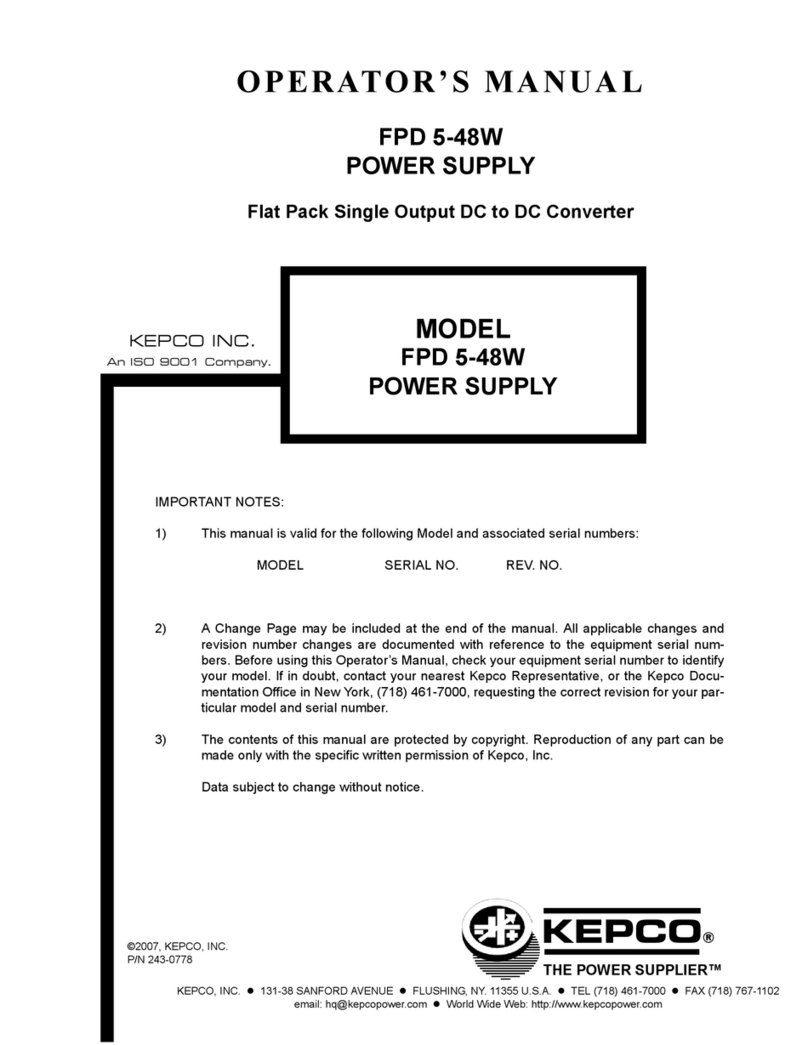Solcon RVS-AX User manual

RVS-AX
Instruction and Commissioning Manual
www.solcon.com
RVS-AX Analog
Low Voltage Soft Starter
8-170 A , 220-600V
Low Voltage Analog Soft Starter
Ver. 1009

2 • Table of Content
________________________________________________________________________________________________
RVS-AX Instruction Manual
1. TABLE OF CONTENT
1. Table of Content ....................................................................................................................2
2. Safety & Warnings.................................................................................................................3
2.1 Safety ......................................................................................................................................3
2.2 Attention ..................................................................................................................................3
2.3 Warnings .................................................................................................................................3
3. Technical Data .......................................................................................................................4
3.1 Introduction..............................................................................................................................4
3.2 Rating and frames sizes...........................................................................................................4
3.3 Starter Selection ......................................................................................................................4
3.4 Mains and control description ..................................................................................................5
3.4.1 Mains Voltage (line to line) (Terminals/bars L1, L2, L3)................................................ 5
3.4.2 Start (Terminals 1, 2).................................................................................................... 5
3.4.3 Neutral (Terminal 3)...................................................................................................... 5
3.4.4 Open terminal (Terminal 4)........................................................................................... 5
3.4.5 End Of Acceleration (terminals 5, 6)............................................................................. 5
3.4.6 Fault Contact (terminals 7, 8)........................................................................................ 5
3.5 Built-in Bypass (RVS-AX31A and higher).................................................................................6
3.6 Soft starter protections.............................................................................................................6
3.6.1 Electronic Overload...................................................................................................... 6
3.6.2 Phase Loss...................................................................................................................6
3.6.3 Heatsink over temperature protection........................................................................... 6
3.6.4 Fault Logic and Reset Circuits...................................................................................... 7
3.7 Starter selection tables for various voltage ratings...................................................................7
3.7.1 Ordering Information..................................................................................................... 8
4. Recommended Wiring Schemes ..........................................................................................9
4.1 Typical wiring diagram .............................................................................................................9
4.2 Wiring Notes............................................................................................................................9
4.2.1 Short Circuit Protection............................................................................................... 10
4.2.2 Transient Protection ................................................................................................... 10
5. Dimensions..........................................................................................................................11
6. Installation............................................................................................................................13
6.1 Prior to Installation.................................................................................................................13
6.2 Mounting................................................................................................................................13
6.3 Tightening Torques................................................................................................................13
6.4 Temperature range & heat dissipation ...................................................................................14
6.4.1 Heat dissipation during RUN of RVS-AX8A and RVS-AX17A (No internal bypass) .... 14
6.4.2 Calculating the enclosure size, for non-ventilated metallic enclosure.......................... 14
6.4.3 Additional Ventilation.................................................................................................. 14
7. Front Panel...........................................................................................................................15
7.1 Potentiometers settings..........................................................................................................15
7.2 Indication LEDs and RESET button .......................................................................................17
8. Starting Procedure ..............................................................................................................18
8.1 Standard starting procedure...................................................................................................19
8.2 Examples of starting curves...................................................................................................20
9. Trouble Shooting.................................................................................................................21
9.1 Warranty Claim and Fault Inquiry...........................................................................................22
10. Technical Specifications.....................................................................................................23

3 • Safety & Warnings
________________________________________________________________________________________________
2. SAFETY & WARNINGS
2.1 Safety
1
Read this manual carefully before operating the equipment and follow its
instructions.
2
Installation, operation and maintenance should be in strict accordance
with this manual, national codes and good practice.
3
Installation or operation not performed in strict accordance with these
instructions will void manufacturer’s warranty.
4
Disconnect all power inputs before servicing the soft-starter and/or the
motor.
5
After installation, check and verify that no parts (bolts, washers, etc.)
have fallen into the starter.
6
During shipping, the soft-starter might have been roughly handled,
therefore, it is recommended to initialize the soft-starter by connecting
supply voltage prior to operating the soft-starter with a motor
2.2 Attention
1
This product was designed for compliance with IEC 947-4-2 for class A
equipment.
2
Use of the product in domestic environments may cause radio
interference, in which case, the user may be required to employ
additional mitigation methods.
3
Utilization category is AC-53a or AC53b, Form 1. For further information,
see Technical Specification
2.3 Warnings
1
Internal components and P.C.Bs are at mains potential when the RVS-
AX is connected to mains. This voltage is extremely dangerous and will
cause death or severe injury if contacted.
2
When RVS-AX is connected to mains, even if start command has not
been issued and motor is stopped, full voltage may appear on starter’s
output and motor’s terminals.
Therefore, for isolation purposes it is required to connect an isolation
device upstream to the RVS-AX.
3
The starter must be properly grounded to ensure correct operation, safety
and to prevent damage.
4
Check that Power Factor capacitors are not connected to the output side
of the soft starter.
5
Do not interchange line and load connections
The company reserves the right to make any improvements or modifications to its products without
prior notice.

4 • Technical Data
________________________________________________________________________________________________
3. TECHNICAL DATA
3.1 Introduction
The RVS-AX electronic soft starter incorporates six thyristors (Three phase control) to start a three-phase
squirrel cage induction motor and an internal bypass (Internal bypass in RVS-AX31A and higher).
By supplying a slowly increasing voltage, it provides soft start and smooth stepless acceleration, while drawing
the minimum current necessary to start the motor.
A Soft Stop feature can be enabled when the Ramp-Down potentiometer is adjusted. When used, upon stop
Signal, motor's voltage is slowly reduced to zero.
The RVS-AX incorporates a built in motor protection of Overload protection and Phase loss protection.
The RVS-AX incorporates an internal protection to protect its heatsinks from over heating.
No control voltage is required to operate the RVS-AX.
3.2 Rating and frames sizes
3.3 Starter Selection
Select the starter according to motor's Full Load Ampere (FLA) - as indicated on its nameplate (even if the
motor will not be fully loaded).
The RVS-AX is designed to operate under the following maximum conditions:
Ambient
Temperature
[
0
C]
Starting Current
[A]
Acceleration Time
[sec]
40
300%xIn
30
350%xIn
20
400%xIn
5
Max. starts per Hour: four (4) starts per hour at maximum ratings and up to 10 starts per hour at light load
applications (consult factory).
Note:
For very frequent starts (inching applications) the inching current should be considered as the Full Load
Current (FLC) (consult factory).
RVS-AX
model
FLC
[A]
Dimensions
WxHxD
[mm]
Weight
[kg]
EOA Relay
Fault Relay
Internal
bypass
RVS-AX 8
8
120x232x105
2.6
No
RVS-AX 17
17
120x232x105
2.6
No
RVS-AX 31
31
120x232x105
2.6
RVS-AX 44
44
120x232x105
2.6
RVS-AX 58
58
129x275x185
5
RVS-AX 72
72
129x275x185
5
RVS-AX 85
85
120x380x185
8.4
RVS-AX 105
105
120x380x185
8.4
RVS-AX 145
145
172x380x195
11.8
RVS-AX 170
170
172x380x195
11.8
Notes:
•() – Standard
•Refer to section 5 on page 11 for detailed dimensions.

5 • Technical Data
________________________________________________________________________________________________
3.4 Mains and control description
3.4.1 Mains Voltage (line to line) (Terminals/bars L1, L2, L3)
Five mains voltage levels are available: 230V, 400V, 440, 480V, 600V.
Note:
230 220 - 240 Vac +10% -15%
400 380 - 415 Vac +10% -15%
440 440 Vac +10% -15%
480 460 - 500 Vac +10% -15%
600 575 - 600 Vac +10% -15%
3.4.2 Start (Terminals 1, 2)
Start/Stop command is initiated by closing/opening a voltage free contact (Dry contact)
Close: Start command.
Open: Stop command.
WARNING!
Never apply voltage to terminals 1, 2.
Start/Stop with a maintained contact!
When the line contactor is operated by a maintained contact, in case of Mains
failure, the motor will be automatically restarted upon voltage restoration!
3.4.3 Neutral (Terminal 3)
Neutral wire (when used) is required only for operation of the Phase Loss Protection (Phase Loss can not be
detected when Neutral is not connected to Terminal 3).
See detailed description in “Phase Loss” explanation section 3.6.2 page 6 .
3.4.4 Open terminal (Terminal 4)
This terminal is of no use. Leave this terminal not connected.
3.4.5 End Of Acceleration (terminals 5, 6)
Voltage free, N.O., 8A / 250VAC, 1800VA max.
The contact closes after the time adjusted on the "Ramp-Up" potentiometer. The contact returns to its original
position on stop signal, on fault condition, upon voltage outage and at the beginning of Soft Stop.
This contact can be used for:
•Activating a valve after a compressor has reached full speed.
•Activating a valve after a pump has reached full speed.
•Loading a conveyor after the motor has reached full speed.
3.4.6 Fault Contact (terminals 7, 8)
Voltage free, N.O , 8A, 250VAC, 1800VA max.
The contact changes its position upon fault and returns to its original position after fault has been removed
and starter was reset. When disconnection of mains supply the contacts will be opened.
WARNING!
Do not use the Fault contact to trip an upstream contactor!
When the Fault contact trips the upstream contactor, Mains voltage will be
disconnected, thus resetting the starter and the motor will restart instantaneously
upon voltage restoration. (See also section 3.6.4 on page 7).
When resetting after a fault with the Reset button, the motor will restart upon
fault reset.
It is therefore recommended not to connect the fault relay to the line contactor.

6 • Technical Data
________________________________________________________________________________________________
3.5 Built-in Bypass (RVS-AX31A and higher)
The RVS-AX (31A model and higher) incorporates three internal bypass relays allowing current flow through
the thyristors only during starting process. At the end of the starting process, the built-in relays bypass the
thyristors and carry the current to the motor.
Upon stop signal, or in case of fault, bypass relays will open and stop the motor.
When Ramp-Down potentiometer is set to allow soft-Stop process, upon stop command, the bypass relays will
open immediately and the current will flow through the thyristors. The voltage will then be reduced slowly and
smoothly to zero.
3.6 Soft starter protections
3.6.1 Electronic Overload
The built-in inverse time electronic overload becomes operational after end of acceleration process.
Trip current is factory set to 115% of Motor Full Load Current (from the setting on Motor FLC potentiometer),
E.g. In order to increase the O/L trip point increase FLC setting above the calculated level.
Electronic overload curve
When this protection activates Overload LED on the front panel will light.
3.6.2 Phase Loss
The protection becomes operational when the starter is energized.
It protects the motor from single phasing. It will trip the starter when one phase is missing for more than 1 sec.
When this protection activates Phase Loss LED on the front panel will light.
Notes:
•Phase loss protection operates only when Terminal 3 is connected to Neutral.
•When phase loss occurs during starting or when motor is not loaded, it may happen that motor will
stop without accurate indication of the Phase Loss LED.
3.6.3 Heatsink over temperature protection.
The protection becomes operational when the starter is energized.
It protects the soft starter from over heating.
A thermal sensor mounted on the heatsink trips the starter when its heatsink temperature rises above 85ºC.
When this protection activates Over-temp LED on the front panel will light.
WARNINGS!
The heatsink over temperature protection is designed to operate under normal
conditions and will operate in case abnormal conditions occur:
•Incorrect starter selection
•Too frequent starting at maximum conditions
•Repeated starting under fault conditions
•Extended low overload
•Insufficient ventilation
•Other abnormal conditions
Note:
In case of frequent starting the internal thyristors may overheat before the
heatsink reaches its over-temperature protection of 85ºC, thus causing
component malfunction.
1
10
100
1000
0 2 4 6
I(Load)/In
Seconds
53
1

7 • Technical Data
________________________________________________________________________________________________
3.6.4 Fault Logic and Reset Circuits
Upon operation of any protection, the starter locks in a fault mode, disabling thyristors firing. The proper fault
indication LED lights and the Fault contact closes.
To reset the starter, after the fault has been removed, press Reset button on starter's front panel or disconnect
Mains voltage.
WARNING!
When starter is operated by a maintained contact, resetting the fault will start
the motor immediately!
Do not use the Fault contact to trip an upstream contactor. When the Fault
Contact closes on fault and trips the upstream contactor, Mains voltage will be
disconnected, thus resetting the RVS-AX and the motor will restart
instantaneously (see Fault Resetting).
3.7 Starter selection tables for various voltage ratings.
1
The starter selection table below concern standard, 1500r.p.m. 50Hz,
three-phase motors.
2
These values are given for guidance and may vary according to motor
manufacturer and depending on the number of poles.
3
It is the user’s responsibility to make sure that motor’s FLA will never
exceed Starter’s FLC.
Starter model
Starter
FLC
[A]
Motor kW
@230V
[kW]
Motor kW
@400V
[kW]
Motor kW
@480V
[kW]
Motor kW
@600V
[kW]
RVS-AX 8
8
1.5
3
4
5.5
RVS-AX 17
17
4
8
9
12.5
RVS-AX 31
31
8
15
18.5
25
RVS-AX 44
44
12.5
22
25
30
RVS-AX 58
58
15
25
37
45
RVS-AX 72
72
20
37
45
59
RVS-AX 85
85
25
45
55
59
RVS-AX 105
105
30
55
59
80
RVS-AX 145
145
40
75
90
110
RVS-AX 170
170
51
90
110
140

8 • Technical Data
________________________________________________________________________________________________
3.7.1 Ordering Information
RVS-AX
31-
400-
0-
S
Full load
Current
Mains
Voltage
Options
Front
Panel
Full load Current
Specify
Description
Starter’s
FLC [A]
8(1), 17(1), 31, 44, 58, 72, 85, 105, 145, 170
Mains Voltage
Specify
Description
230
220 - 240 Vac +10% -15%
400
380 - 415 Vac +10% -15%
440
440 Vac +10% -15%
480
460 - 500 Vac +10% -15%
600
575 - 600 Vac +10% -15%
Options
Specify
Description
0
No options
U
UL & cUL approval
8
Harsh environment treatment
Front Panel
Specify
Description
S
Standard lexan
Notes:
(1) No internal bypass in RVS-AX 8, 17A.
Example:
RVS-AX rated 145A, mains voltage- 208V, harsh environment treatment, UL approved and standard front
panel:
RVS-AX 145 - 208 – 8-U – S

9 • Recommended Wiring Schemes
________________________________________________________________________________________________
4. RECOMMENDED WIRING SCHEMES
4.1 Typical wiring diagram
Notes:
(1) - Use fuses for type 2 coordination. Refer to section 4.2.1 on page 10
(2) – Use a maintained contact to start the motor. Open the contact to soft stop/stop the motor.
Contact must be closed one second after voltage at L1, L2, L3 is stable.
Never apply voltage to terminals 1 & 2.
(3) – Connect terminal 3 to system neutral. If not connected to neutral, phase loss protection
might not function as required. Refer to section 3.6.2 on page 6.
(4) – Leave terminal 4 not connected.
(5) – No internal bypass in RVS-AX8A and RVS-AX17A.
4.2 Wiring Notes
WARNINGS!
When mains voltage is connected to the RVS-AX, full voltage may appear on the starter
load terminals.
Therefore, for isolation purposes, it is necessary to connect an isolating device before
the starter.
Power factor correction capacitors must not be installed on starters load side. When
required, install capacitors on starter’s line side.
Never connect the RVS-AX “Inside Delta”! (Consult factory)
When starter is operated by a maintained contact, resetting a fault will start the motor
immediately!
When the line contactor is operated by a maintained contact, in case of Mains failure,
the motor will be automatically restarted upon voltage restoration!
Do not use the Fault contact to trip an upstream contactor!
When the Fault contact trips the upstream contactor, Mains voltage will be
disconnected, thus resetting the starter and the motor will restart instantaneously upon
voltage restoration!

10 • Recommended Wiring Schemes
________________________________________________________________________________________________
4.2.1 Short Circuit Protection
For “class 2 coordination”, protect the starter against a short circuit by thyristor protection fuses for I²t and
fuses as in dictated in the following table:
RVS-AX type
I²t (A²S)
Ferraz Fuses
RVS-AX 8
400
6,6 URS 35
RVS-AX 17
2,000
6,6 URS 45
RVS-AX 31
3,000
6,6 URS 63
RVS-AX 44
6,000
6,6 URB 100
RVS-AX 58
12,000
6,6 URB 150
RVS-AX 72
18,000
6,6 URB 160
RVS-AX 85
40,000
6,6 URD 200
RVS-AX 105
60,000
6,6 URD 250
RVS-AX 145
100,000
6,6 URD 355
RVS-AX 170
140,000
6,6 URD 400
4.2.2 Transient Protection
Line transient voltages can cause a malfunction of the starter and damage to the thyristors. All RVS-AX
starters incorporate Metal Oxide Varistors (MOV) to protect from normal line voltage spikes.
When higher transients are expected, additional external protection should be used (consult factory).

11 • Dimensions
________________________________________________________________________________________________
5. DIMENSIONS
RVS-AX 8, 17, 31, 44
Note: Mains voltage terminals: 16mm
2
RVS-AX 58, 72

12 • Dimensions
________________________________________________________________________________________________
RVS-AX 85, 105
RVS-AX 145, 170

13 • Installation
________________________________________________________________________________________________
6. INSTALLATION
WARNING!
Do not interchange line and load connections
Do not connect the RVS-AX “Inside Delta” (consult factory)
6.1 Prior to Installation
Check that Motor’s Full Load Ampere (FLA) is lower than, or equal, to the starter’s Full Load Current (FLC)
and that Mains and Control voltages are as indicated on the starter’s side label.
Make sure Starter’s FLC≥ Motor FLA!
Make sure Mains voltage is right!
Make sure control is by voltage free contact!
RVS-AX label - example
6.2 Mounting
The starter must be mounted vertically. Allow sufficient space (at least 100mm) above and below the starter
for suitable airflow.
It is recommended to mount the starter directly on the rear metal plate for better heat dissipation.
Do not mount the starter near heat sources.
Surrounding air temperature in the cabinet should not exceed 40ºC
Protect the starter from dust and corrosive atmospheres.
Note: For harsh environments (sewage treatment plants, etc.), it is recommended to order the starter with
printed circuit board coating. Refer to section 3.7.1 on page 8 for ordering information.
6.3 Tightening Torques
All control terminals 1-8 should be tighten at 0.5Nm (4.42lbfin).
RVS-AX
model
L1, L2, L3
U, V, W
Gnd
RVS-AX 8
16mm2
terminal 2.5Nm
(22.13lbfin) M4 2Nm
(17.7lbfin)
RVS-AX 17
RVS-AX 31
RVS-AX 44
RVS-AX 58
M6
5.5Nm
(48.68lbfin)
M6
5.5Nm
(48.68lbfin)
RVS-AX 72
RVS-AX 85
M8
15Nm
(132.76lbfin)
M8
15Nm
(132.76lbfin)
RVS-AX 105
RVS-AX 145
M8
15Nm
(132.76lbfin)
M8
15Nm
(132.76lbfin)
RVS-AX 170

14 • Installation
________________________________________________________________________________________________
Area (m2) =
6.4 25BTemperature range & heat dissipation
The starter is rated to operate over a temperature range of -10ºC (14ºF) to + 40ºC (104ºF).
Relative non-condensed humidity inside the enclosure should not exceed 95%.
ATTENTION!
Operating at surrounding air temp. (Inside the cabinet) higher than 40ºC may
cause damage to the starter.
Starter’s heat dissipation while motor is running and the internal bypass relays are closed (RVS-AX31A and
higher) is typically less than 0.4 x In (in watts).
During soft start and soft stop, heating is approximately two times the actual starting current (In watts).
Example: For a 100A motor, heat dissipation is less than 40 watts while running.
Important note: If motor is frequently started, cabinet should be designed for the higher heat dissipation.
Internal enclosure heating can be reduced through the use of additional ventilation.
6.4.1 44BHeat dissipation during RUN of RVS-AX8A and RVS-AX17A (No internal bypass)
Heat dissipation from the RVS-AX8A and RVS-AX17A when external bypass is not applied is calculated as:
Ploss=3x1.3xI
Where:
I – motor current
For example:
During run of RVS-AX17A when motor current is 17A heat dissipation can be calculated as:
Ploss=3x1.3x17=66.3Watt
6.4.2 45BCalculating the enclosure size, for non-ventilated metallic enclosure
Where: Area [m2]]- Surface area that can dissipate heat (front, sides, top).
Total heat dissipation [Watt] – The total heat dissipation of the starter and other control devices in
the enclosure. If starter is frequently started, average power should be used.
6.4.3 46BAdditional Ventilation
Use the following arrangement for forced ventilation of the RVS-AX’s enclosure:
General purpose
enclosure
with filter on the air inlet
and Fan on air outlet.
0.12 x Total heat dissipation [Watts]
60 – External ambient temp. [ºC]

15 • Front Panel
________________________________________________________________________________________________
7. FRONT PANEL
The RVS-AX front panel contains:
(1) Five potentiometers for setting: Motor FLC, Initial Voltage, Current Limit, Ramp Up and Ramp
Down.
(2) Six indication LEDs: On, Ramp Up/Down, Run, Overload, Phase loss, Over temperature
(3) Reset Button
7.1 Potentiometers settings
Potentiometer Range Description
Motor FLC
50-100%
The adjustment allows easy setting of the RVS-AX current level,
automatically adjusting current based functions (Overload, Current Limit,
etc).
Set FLC potentiometer according to the following equation:
100
FLC
FLAMotor
FLC ×=
Where:
Motor FLA is the motor's Full Load Current rating as shown on its
nameplate.
FLC is the starter Full Load Current as shown on its label.
Example:
When starting a 27A motor using RVS-AX 31:
87%100
31
27
FLC% =×=
Therefore set the FLC% to a reading of 87% (see Ex.)
(3)
(1)
(2)
FLC %
50%
100%
°
°
°
°
°
87 %

16 • Front Panel
________________________________________________________________________________________________
Potentiometer Range Description
Initial Voltage
10-50%
Determines the initial voltage to the motor (torque is directly proportional
to the square of the voltage).
Range: 10-50% of nominal voltage.
This adjustment also determines the inrush current and mechanical
shock.
Too high of a setting may cause high initial mechanical shock and high
inrush current (even if Current Limit is set low, as the Initial Voltage
setting over-rides the Current Limit setting).
Too low of a setting may result in prolonged time until motor starts
revolving. The motor should start revolving immediately after Start signal
Current Limit
100-400%
Determines motor's highest current during starting.
Range is 100-400% of FLC (as set on motor's FLC adjustment).
Too high of a setting will allow higher currents to be drawn from mains,
resulting in faster acceleration.
Too low of a setting may prevent the motor from completing the
acceleration process and reaching full speed.
Generally, this setting should be set to the highest acceptable value in
order to prevent stalling.
Caution
Starting Current and time should not exceed the allowable conditions as
shown on section 3.3on page 4.
Ramp Up
2-30 sec.
Determines motor's voltage ramp-up time from initial to full voltage.
It is recommended to set Ramp-Up Time to the minimum acceptable
value (approx. 5 Sec).
Notes:
1. Setting Current Limit low will extend Ramp-Up Time.
2. When motor reaches full speed before voltage reaches nominal,
Ramp-Up Time adjustment is overridden, causing voltage to quickly
ramp up to nominal.
U%
10%
50%
100%
2
30
Sec.
I%
600%
100%
400%
Sec.
U%
100%
2
30
Sec.

17 • Front Panel
________________________________________________________________________________________________
Potentiometer Range Description
Ramp Down
0.2-30 sec.
Used to control deceleration of high friction loads. When Ramp-Down
potentiometer is set, upon stop signal the starter output voltage is
gradually ramped down.
When "Ramp-down Time" is set to minimum, the motor will stop
immediately.
7.2 Indication LEDs and RESET button
Green On Will lit when Mains voltage is connected to the starter.
Yellow Ramp
Up/Down Will lit during soft start and soft stop process, indicating that motor supply voltage
is ramping up or down.
Green Run Will lit after completion of starting process, indicating that motor is receiving full
voltage.
Red Overload Will lit upon operation of the built-in overload protection.
Red Phase
Loss Will lit upon operation of the phase loss protection.
Red Over-
temp Will lit upon operation of the heatsink over temperature protection.
Reset
Button To reset the starter, after the fault has been removed.
U%
0.2
100%
30
sec

18 • Starting Procedure
________________________________________________________________________________________________
8. STARTING PROCEDURE
1
When mains voltage is connected to the RVS-AX, even if start signal has
not been issued, full voltage may appear on the starter load terminals.
Therefore, for isolation purposes, it is necessary to connect an isolating
device before (upstream) the starter.
2
Power factor correction capacitors must not be installed on starters load
side. When required, install capacitors on starter’s line side.
3
Before starting the motor verify its rotation direction. If needed,
disconnect the rotor from the mechanical load and verify the right rotation
direction.
4
Prior to Start up procedure make sure that line voltage match the one
shown on the starter’s name plate.
5
Do not interchange line and load connections
6
Do not connect the RVS-AX “Inside delta”. (Consult factory)

19 • Starting Procedure
________________________________________________________________________________________________
8.1 Standard starting procedure
See next page…
1. Set FLC (Motor Full Load Current) - according to calculation:
100
LCStarter FMotor FLA
FLC ×=
2. Set other potentiometers according to system requirements
(see next page for examples)
3. Connect mains voltage to starter line terminals. On LED will
light.
4. Apply Start command
Motor starts to turn
shortly after Start
Initial inrush current or
mechanical shock is
too high?
Increase “Initial Voltage” and start again
Decrease “Initial Voltage” and start again
Speed accelerates
smoothly to nominal?
Apply Stop command and wait until motor
stops.
Slightly increase Initial Voltage and Current Limit
settings to allow for load changes.
Current during
acceleration is too
high?
Decrease “Current Limit”
Motor speed does not
accelerate to nominal?
Increase “Current Limit”
Yes
No
Yes
No
No
Yes
Yes
No
No
Yes
A

20 • Starting Procedure
________________________________________________________________________________________________
8.2 Examples of starting curves
Light loads - pumps, etc.
(In these cases actual current is always less than Current limit setting)
Current limit - set to 300-350%
Initial Voltage - set to 30%
Ramp-up time - set to 10 sec.
U%
100%
t
I%
600%
100%
50%
30%
10%
400%
350%
t
Upon start, the voltage quickly increases to the Initial Voltage value (30% of Un) and then gradually ramps-up to
nominal.
The current will simultaneously increase to peak current value (Lower than the current Limit setting), before
smoothly decreasing to the operating current.
High inertia loads – crushers, centrifuges, mixers etc.
(In these cases actual current is at Current limit setting in part of the starting time)
Current Limit - set to 400%
Initial Voltage - set to 40%
Ramp-Up time- set to 3 sec.
U%
100%
t
I%
600%
100%
40%
10%
400%
t
Upon start the voltage and current increase until current reaches Current Limit value. The voltage remains at
this value until motor reaches close to nominal speed, where current starts to decrease, voltage continues to
ramp-up to nominal.
End of process
Motor acceleration time
to full speed is as
required?
No
Yes
Apply Start command
If acceleration time is too short, increase
“Acceleration Time” setting and/or decrease C.L.
(when decreasing CL, make sure motor increases
speed gradually and does not stall).
A
Table of contents
Other Solcon Power Supply manuals

